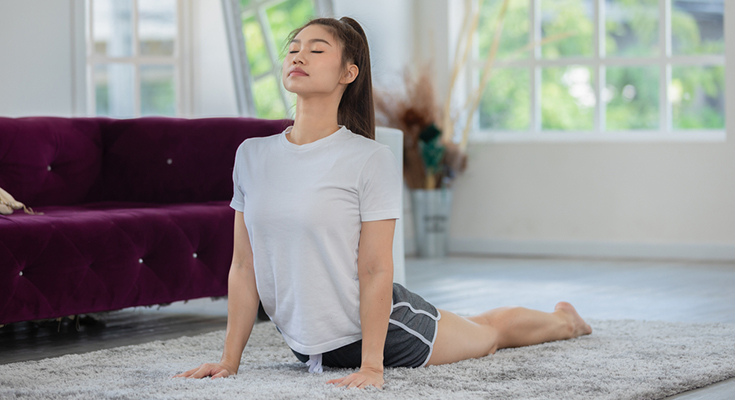Bhujangasana is also known as serpent Cobra pose because when you practise Bhujangasana steps, your body shape looks like a serpent with its head raised.
When you practise Bhujangasana steps, it involves reclining back bending, this is also a part of some yoga asana in Sun Salutation and Padma Sadhana.
The meaning of Bhujang is ‘Snake or Cobra,’ and asana means ‘pose or posture.’ And now it’s time to understand Bhujangasana steps one by one to get an idea of how to practise it correctly to get the maximum Bhujangasana benefits.
Bhujangasana Steps To Practise it Correctly:
1. Get a yoga mat or any other mat and the first Bhujangasana step is to lie down on your stomach side, your forehead should be resting on the ground, and your toes should be flat on the mat.
2. Second, Bhujangasana step is to put your legs close and make sure that your heels and feet are touching and close to each other.
3. Third Bhujangasana step is to place your elbows parallel and near to your torso. Keep your hand under your shoulders and your palm should be downwards.
4. Fourth Bhujangasana step is to inhale deeply and lifting the head, chest and abdomen area slowly. Make your while you are lifting your navel is on the floor.
5. Fifth Bhujangasana step is to pull your torso back with the help of your hands and make sure you equally put pressure on both the hands to avoid any injury or pain.
6. Sixth Bhujangasana step is to keep your arms straight while you are curving your spine vertebra and continue breathing. Tilt your head backwards and look upwards.
7. Things you should while practising Bhujangasana steps are: Make sure your shoulders are not close to your ears, make sure your shoulders are not stiff and relaxed even while bending your elbow.
8. Do not overstretch your spine while practising Bhujangasana steps and make sure you are breathing and your feet are close to each other.
9. While you are exhaling, bring your chest, abdomen and back on downwards on the floor, gently.
Bhujangasana Benefits:
1. Bhujangasana helps to open up your neck and shoulders.
2. Bhujangasana benefits to tone up and strengthen your abdomen muscles.
3. Bhujangasana benefits to expand the chest muscles.
4. Bhujangasana benefits to strengthen the shoulders and back muscles.
5. Bhujangasana benefits to increase the middle-and upper back flexibility.
6. Bhujangasana benefits to improve blood circulation in the body.
7. Bhujangasana benefits you to reduce stress and fatigue.
Do not Practise Bhujangasana steps if:
1. You can practise Bhujangasana steps to improve asthma problem but if you are suffering from an asthma attack then, do not practise Bhujangasana especially during the attack period. Also, consult your doctor no matter what and only then practise this yoga asana.
2. If you have fractured wrists and ribs, do not practise Bhujangasana steps.
3. If you recently went through an abdominal surgery then do not practise Bhujangasana steps.
4. If you are pregnant, do not practise Bhujangasana steps.
5. If you are suffering from carpel tunnel syndrome, do not practise Bhujangasana steps.
6. If you are suffering from a chronic disease then first consult your doctor and then practise this asana and if your doctor is ok with this, then you should practise Bhujangasana steps under a yoga instructor.
If you practise Bhujangasana steps and other yoga asanas daily you feel a change in the overall wellbeing of your mind and body.
Yoga asana provides so many benefits, and once you start the practise of yoga asana, you understand that yoga asana could one of the best alternative to medicines and pills you consume daily to get rid of your health problems.
Yoga is helpful for you as well as children you can practise yoga with your children to teach them how to practise yoga asana from a young age.
And make them understand the importance of being healthy without hitting a gym and paying thousands of bucks every month, instead of using your own body to stay fit.

